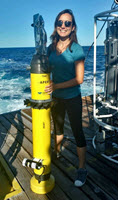
During the Deepwater Horizon incident, some models predicted that oil would reach the Florida coastline. However, much of the oil became trapped in cyclonic-like currents, which are eddy flows associated with the Loop Current, and exited the Gulf of Mexico without reaching the Florida coast. To improve model representations of the Loop Current, Luna Hiron utilizes in situ and satellite data to investigate interactions between the Loop Current and its associated eddies and how they affect the Loop Current’s variability, which can improve predictions for where floating material such as oil may travel.
Luna is a Ph.D. student with the University of Miami’s Rosenstiel School of Marine and Atmospheric Science (RSMAS) and a GoMRI Scholar working on the project Three-Dimensional Gulf Circulation and Biogeochemical Processes Unveiled by State-of-the-Art Profiling Float Technology and Data Assimilative Ocean Models.
Her Path
From a young age, Luna often questioned the “why” of things. This natural curiosity and a passion for the ocean, like her father had, inspired her to become an oceanographer when she was an elementary school student. Her inspiration continued, and she completed a bachelor’s degree in oceanography at the Federal University of Santa Catarina in Brazil and became a research technician collecting and analyzing data for the Bermuda Institute of Ocean Sciences’ Bermuda Atlantic Time-Series Study (BATS). “My experience with BATS gave me new insights about the career of an oceanographer,” said Luna. “I developed a good understanding of large scale oceanography and wanted to broaden my horizons [through further education].”
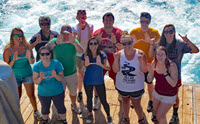
Luna searched for a Ph.D. program where she could learn more about mesoscale ocean processes, which are complex and crucial to understanding ocean dynamics. She was drawn to Dr. Nick Shay’s research about the Gulf of Mexico Loop Current and accepted a Ph.D. position in his lab at the University of Miami. “It is exciting to explore new problems that have not have been solved yet,” she said. “The Loop Current system is complex and involves both large and mesoscale features. My goal is to bring some insight into these dynamics and help better understand the Loop Current system.”
Her Work
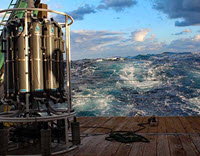
The Loop Current has several life cycle stages, which can be tracked by satellite, that include retracting (the Loop Current goes directly from the Yucatan Channel to the Florida Strait), bulging (the Loop Current grows and enters the Gulf of Mexico and forms a “loop” before exiting through the Florida Strait), and shedding (the Loop Current becomes unstable and sheds an eddy. Luna combines satellite data from 2009 – 2011 that documented the Loop Current’s evolving stages and its associated eddies with water column data on temperature, salinity, and velocity (surface to 2900 m depth). Her analyses show that cyclone eddies often become stronger near the Loop Current, attracting the surrounding flow to the eddy’s center and strengthening the Loop Current as they interface. She also observed that cyclone eddies appear to interact with the Loop Current during all of the Current’s life stages and not just the shedding stages, an important insight into Loop Current dynamics.
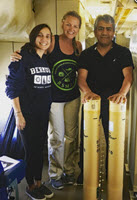
Luna’s observations about how eddies intensify or dissipate are crucial to forecasting oil transport and demonstrate the importance of sampling the ocean during all Loop Current life stages. “If an eddy is in a stage of intensification near an oil patch, it will attract the oil to the cyclone’s center and push it downwards, capturing the oil within the eddy and preventing it from reaching the coast, which is what happened during the Deepwater Horizon spill,” she said. “However, if the eddy is starting to break up, it will spread the oil at the surface and increase the area contaminated.”
Her Learning
Luna’s work in Dr. Shay’s lab exposed her to a wide range of research topics, such as air-sea interactions and ocean dynamics, which enriched her learning and provided her with multidisciplinary knowledge. She learned new approaches to the scientific process, especially the importance of identifying knowledge gaps and generating a hypothesis before attempting to answer questions. She explained that the lab’s collaborative nature taught her about teamwork, communicating science to the public, and conducting science with integrity and honesty.
Luna shared her most unforgettable experiences working with Dr. Shay. “A memorable moment was when I flew in the WP-3D aircraft from NOAA during the post-Hurricane Nate survey. It was incredible to be in a plane that flew through so many strong hurricanes,” she said. “Another great memory was when we were on a cruise deploying floats in the Gulf of Mexico and about seven dolphins were swimming in front of the ship for at least 30 minutes – it was amazing!”
Her Future
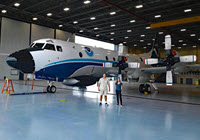
Luna hopes to pursue advanced studies or a position in a research institute after graduation. For students considering a science career, she suggests that they stay motivated, find what they love to do, and believe in themselves. “It is important to not be intimidated by other students or professors – ask questions and make contact! All of this is part of the learning process, and we always have more to learn and exchange with each other.”
Praise for Luna
Dr. Shay described Luna as a talented and energetic student and praised her collaboration with students and researchers across various disciplines and institutions. He explained that she is a productive team member working with Bureau of Ocean Energy Management (BOEM) mooring data, generating model simulations that investigate Loop Current-associated eddies, and helping collect shipboard measurements using EM-APEX (Electromagnetic-Autonomous Profiling Explorers) floats.
“Luna is preparing a manuscript for submission to a top tier journal and has submitted an abstract for presentation to the 2019 Gulf of Mexico Oil Spill and Ecosystem Science,” said Shay. “Her work is central to understanding the dispersion of hydrocarbons from a subsurface oil spill in the vicinity of strong subsurface currents.”
The GoMRI community embraces bright and dedicated students like Luna Hiron and their important contributions. The GoMRI Scholars Program recognizes graduate students whose work focuses on GoMRI-funded projects and builds community for the next generation of ocean science professionals.
By Stephanie Ellis and Nilde Maggie Dannreuther. Contact sellis@ngi.msstate.edu for questions or comments.
************
The Gulf of Mexico Research Initiative (GoMRI) is a 10-year independent research program established to study the effect, and the potential associated impact, of hydrocarbon releases on the environment and public health, as well as to develop improved spill mitigation, oil detection, characterization and remediation technologies. An independent and academic 20-member Research Board makes the funding and research direction decisions to ensure the intellectual quality, effectiveness and academic independence of the GoMRI research. All research data, findings and publications will be made publicly available. The program was established through a $500 million financial commitment from BP. For more information, visit https://gulfresearchinitiative.org/.
© Copyright 2010-2018 Gulf of Mexico Research Initiative (GoMRI) – All Rights Reserved. Redistribution is encouraged with acknowledgement to the Gulf of Mexico Research Initiative (GoMRI). Please credit images and/or videos as done in each article. Questions? Contact web-content editor Nilde “Maggie” Dannreuther, Northern Gulf Institute, Mississippi State University (maggied@ngi.msstate.edu).
